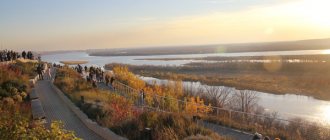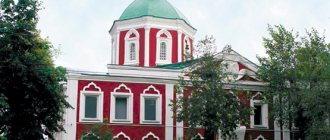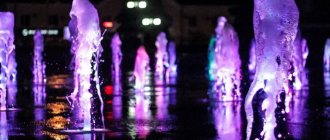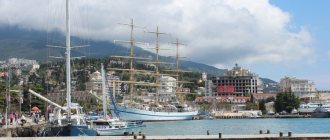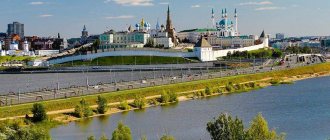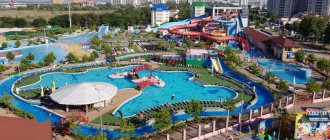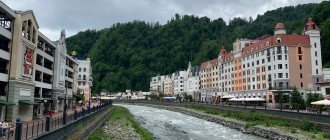Krasnodar is not one of the oldest cities in Russia, but its rich history is over two hundred years old. It was founded back in 1793 and was originally called Ekaterinodar, in honor of Empress Catherine II. Since the Soviet government decisively eradicated all names that referred to the era of tsarism, the city was renamed Krasnodar, where red was a symbol of revolution and communism.
Today, Krasnodar is one of the twenty largest cities in Russia - its population as of 2022 is 948 thousand people.
The excellent climate, proximity to the sea and the interweaving of many cultures, the bearers of which were assimilated in the Krasnodar region, created favorable conditions for the development of tourism. Krasnodar is one of the most visited cities in Russia, especially during the summer holidays. Of course, this beautiful city has a large number of attractions that are loved not only by local residents, but also by tourists. Let’s take a closer look at what you can see in Krasnodar in 1 day on your own.
Galitsky Park (FC Krasnodar Park)
Galitsky Park is in first place on our list for a reason. The park is very different from other attractions in Krasnodar, and from other parks in our country. Something new and modern immediately catches your eye upon entering, and you continue to be amazed by it throughout your entire walk through the park.
Advice : set aside at least 3 hours for a walk in the park to take a leisurely walk and see everything. The park is large and there are many locations in it, and most importantly, they are very beautiful and interesting.
We were passing through Krasnodar, on the way to Crimea by car, so we didn’t have much time reserve; 3 hours was enough for us to visit the park.
We also recommend arriving at the park early. The place is very popular among tourists and among local residents. It is much more pleasant to enjoy the park and take photos when it is not yet crowded. We arrived at the park around 8:30 in the morning and it was almost empty, but by 10 there were already much more people.
Only photographs can tell more about the stadium, so we offer a brief overview of the park’s locations.
The park has a huge number of plants that were brought from European countries.
The Japanese carp pond is a quiet place to sit and admire the unusual fish.
The park has a cool amphitheater that seats up to 200 people. During the summer season, films are shown there absolutely free of charge in the evenings.
An interesting location in the form of a “point on the map” mark. At first glance, it may seem that the surface is smooth and the surrounding area is reflected on it, but in fact, a panoramic image of the surrounding area is, as it were, “pressed” into a ball, that is, a three-dimensional panorama is obtained.
The park impressed with its set:
- fountains. There are them for every taste and every size;
- holiday locations. Each location is separated from the general area of the park, usually by vegetation. That is, having settled down to relax on a sun lounger, you will not be in full view of the entire park - it is very comfortable;
- plants. There are flowers, local plants and even foreign ones.
Let's go to the center: routes and prices
It is better to explore the sights of Krasnodar starting from the center.
Path from the airport
The distance from Pashkovsky Airport to the center is 12 km. You have 2 options: order a taxi or use public transport.
Private traders are waiting for clients near the airport. There is no clear tariff; it all depends on the ability to bargain. You can also order an accredited taxi at the counter in the airport building or go online and make an order online. The last option is the most budget-friendly. The cost is known in advance and starts from 350 rubles. and higher.
The most accessible transport is city transport. To get to the center, you need to get to the Krasnodar-1 railway station (not to be confused with the second station) and make a transfer. The journey will take about 1 hour. Choose minibus No. 53 or trolleybus No. 7. The fare is the same: 28 rubles.
Path from the railway or bus station
The route in both cases is the same, because The bus station building is located a 5-minute walk from the railway station on the station square. Choose bus No. 2E, trolleybus No. 2 or 8, minibus No. 20, 53 or 9. Be prepared for the fact that you will have to pay an additional 28 rubles for bulky luggage.
Path by car
The shortest and fastest route from the railway station to Krasnaya Street passes through Levanevsky and Budyonny Streets. The distance is just over 3 km.
Red Street
The original meaning of the word “red” in Russian is “beautiful”. And the central street of Krasnodar fully corresponds to this definition - there are so many parks and public gardens neatly scattered on both sides of the street, and they are so well-groomed that walking along it is extremely pleasant. In addition, the best restaurants and cafes of the city are concentrated there - you can have a tasty snack and continue your walk, also buying souvenirs along the way - after all, pleasant shops selling them are located literally on every corner of the street.
You can also often meet street performers and musicians there, talentedly performing a variety of music. In addition, it is on this street that the city and regional administration buildings are located, which delight the eye with pleasant architecture. In one of the squares at the intersection with Postovaya Street there is a picturesque monument to Catherine the Second, thanks to whom the city was founded.
"Song about a Friend"
The best way to start a one-day tour of Krasnodar is from Aleksandrovsky Boulevard; it is part of the most famous street with a beautiful name – Krasnaya. Here you can enjoy the relative silence and develop a walking route for one day. If there are adult vacationers in the group, then it’s worth checking out Vladimir Vysotsky’s House of Creativity, it’s located not far from the boulevard. In this cultural center it is easy to:
- get acquainted with exhibitions dedicated to the outstanding actor, performer, poet and composer;
- view art exhibitions;
- listen to famous hits and songs unknown to the general public by Vladimir Semenovich Vysotsky.
Next, the question of where to go in Krasnodar is resolved very quickly - on the street. Red, where many interesting places, monuments and establishments await the guest.
St. Catherine's Cathedral
This beautiful work of Russian architecture belongs to the Kuban Metropolis of the Russian Orthodox Church. The majestic brown cathedral building with large golden domes was erected in 1900 as thanks to higher powers for saving the royal family, which in 1889 was wrecked on a railway, but remained unharmed. The cathedral is the main operating temple of the Krasnodar region.
In 2012, restoration work was carried out, the walls were repaired, and the domes were covered with gold leaf, the shine of which pleases the eyes of parishioners. The cathedral is not only a temple, but also an architectural monument; visiting its territory is free. However, do not forget about the rules of behavior: you need to behave quietly and modestly in the temple, clothing should be appropriate for the occasion. When visiting a temple, do not forget about Sunday services and church holidays, which may interfere with sightseeing.
Monuments
The main attractions of Krasnodar are the monuments, of which there are a lot in the city.
Monument to Catherine the Great
The most majestic of them is dedicated to the Russian Empress Catherine II.
In 1792, Catherine the Great gave the Kuban lands to the Black Sea Cossacks. This is how the city of Ekaterinodar appeared on the map, bearing this name until 1920. With the arrival of the Bolsheviks it was renamed Krasnodar. The sights of the city are associated with the Kuban Cossacks, with the historical figure Catherine II, with the Great Patriotic War, when German invaders entered here in 1942 and destroyed about 13 thousand of the local population in gas chambers.
Not a single tourist passes by it. This monumental sculptural composition makes us remember Russian history. The monument symbolizes the tribute of the Kuban people to Catherine the Great. A majestic and wise woman, dressed in a solemn royal robe (porphyry), with a scepter and orb in her hands, rises in the very center of the city. The project was developed by the outstanding Russian sculptor Mikhail Mikeshin, but he did not have time to complete his creation, as he died suddenly. His work was continued by the equally talented master Boris Eduard, and in 1907 the grand opening of the monument took place. Only its fate was short-lived; in 1920, representatives of the Soviet government completely destroyed the monument. In 2002, the governor of the Krasnodar region, Alexander Tkachev, came up with the idea of restoring the work of art. According to archival documents and drawings, the monument was cast, and in 2006, Catherine the Great took her place of honor in the city of Krasnodar.
What other monuments should I see?
While walking around the city, be sure to find the following monuments:
- Opposite the Kuban State Technical University there is a monument to “Students”, otherwise it is called “Shurik and Lida”. You won’t be able to pass by him, you just want to take a photo as a souvenir and look at Lidochka’s notes.
- While walking along Krasnaya Street, look for the sculptural composition “Cossacks writing a letter to the Turkish Sultan.” The masters, with all the subtleties and details, turned the famous painting by Repin into a monument.
- A huge number of monuments dedicated to the heroes of the Great Patriotic War. You should definitely find them and visit them. This is not only the tragic history of Russia, but also our deep worship of those who did not return from the front and won a peaceful life for us.
- On the 25th anniversary of the tragedy at the Chernobyl nuclear power plant (in 2011), a monumental composition was erected to the liquidators of the accident. She took 1st place in Russia in the competition program “Patriotism and Loyalty to Duty.”
- A positive monument is “Walking (or loving) dogs.” It would seem that there is nothing special in the sculpture. But the dogs are so charming that they put everyone in a great mood and smile. The composition was inspired by a poem by Mayakovsky, the poet called Krasnodar “the dog capital.” After visiting this sculpture, you will certainly begin to take a closer look at the local residents, and you will find that many of them are walking with their dogs.
- Very beautiful Orthodox monuments - the Holy Great Martyr Catherine, Peter and Fevronya of Murom.
- There are many personal (named) monuments to the Russian poets A. S. Pushkin and S. A. Yesenin; Marshal of the Soviet Union G.K. Zhukov; Russian military leaders L. G. Kornilov and A. V. Suvorov; the wonderful Soviet actress Klara Luchko; fighter pilot A.I. Pokryshkin; painter I. E. Repin.
Drama theatre
The Krasnodar Academic Drama Theater named after M. Gorky is, without exaggeration, one of the best theaters in the country. Tourists should visit this place if only for the sake of the magnificent building, which has no analogues in the country.
It is worth noting that the current theater building was erected after the Great Patriotic War, on the same spot where the old building stood, completely destroyed during the occupation of Krasnodar by German troops in 1943.
Where to dine in the center: cuisine, average bill and reviews
On Krasnaya, everyone will find a place where they have delicious food and quality service. The cafes in Krasnodar serve dishes from different cuisines. Since there is a lot of competition, establishment owners try to attract customers by creating a cozy and unusual atmosphere.
Bumbarash
This is the most colorful restaurant in Krasnodar. Authentic design and excellent Georgian cuisine attract visitors. The menu includes kutabs, shish kebab, kharcho, and wine. On Fridays, guests can listen to the singing of Georgian vocalists. Even the waiters dance to the fiery rhythms. Reviews about “Bumbarash” are the most enthusiastic. Average check: 500 rub. Address: st. Krasnaya, 143/3, site.
Fritteria Pythagoras
The Pythagoras Fritteria recently opened in an unusual pyramid-shaped building. The menu includes Belgian potatoes, churros, and Black Sea seafood popcorn. Guests like the unusual exterior and fast service. Average check: 300 rub. Address: st. Krasnaya, 111/1, Instagram.
Coral beads
The menu of the Coral Beads restaurant contains recipes from all over the world. In summer, guests can sit on the terrace and enjoy city views from the panoramic rooftop. Next to the restaurant there are “Singing Fountains”, which is especially popular among visitors. Average check: 450 rub. Address: st. Krasnaya, 169/1, website, Instagram.
Ballerina and Beefsteak
The establishment is called a cultural event in the life of the capital of Kuban. The menu offers a selection of steaks in different varieties. In addition, you can find unusual dishes. For example, Ural posikunchiki. Average check: 500 rub. Address: st. Krasnaya, 40, website, Instagram.
Alexander Nevsky Cathedral
The spiritual side of the city is represented by another beautiful cathedral, which was less fortunate than St. Catherine’s Cathedral - in 1932, by order of the Soviet authorities, the Alexander Nevsky Cathedral was destroyed to the ground by explosion. For a long time, city residents asked for the restoration of the temple, but this was only done in 2003. Construction in accordance with the historical appearance, which they tried to recreate from archival photographs and documents, took a long time, but now the newly erected temple is open to the public.
The temple was originally built in 1853 and was the main military temple of Krasnodar. Relics of the Kuban Cossack army were kept there, all the main Cossack holidays were held, and a church Cossack choir functioned, which became the prototype of the modern Kuban Cossack choir. Some relics that were kept in the temple before the revolution were preserved, and now they are presented in the temple as museum exhibits. Visiting the temple is free.
What to see in 1 day on your own
Krasnodar is often visited for 1 day while passing through - on the way to the Black Sea coast. The city is pleasant for leisurely walks - despite the absence of the sea, there is a relaxed resort atmosphere here. The city has a well-developed infrastructure - many cafes and restaurants of a decent level, interactive museums and entertainment venues. Where to start getting acquainted with Krasnodar? Go to Catherine Square.
Catherine Square
A small square with a monument to Empress Catherine II , who issued a charter to the Cossacks for ownership of the Kuban land, is perfect for starting to get acquainted with Krasnodar. The monument was erected at the beginning of the 20th century - the opening was timed to coincide with the 200th anniversary of the Kuban Cossack army. In those days, the monument to Catherine II was considered the main city attraction. But in the 20s, the monument was destroyed by the Bolsheviks. The monument was restored only in 2006 using archival photographs of the first monument. It depicts the empress with a scepter and orb. At the pedestal stand Prince Potemkin (on the left) against the backdrop of battle banners and atamans of the Cossack troops (on the right), behind is a blind kobzar singer and a list of the empire’s victories won with the participation of Cossack troops is listed.
The square is surrounded by important city buildings. On the right is the military cathedral of Alexander Nevsky in the pseudo-Russian style (built in 1853, destroyed in the 30s of the 20th century and restored in 2003-2006). Previously, relics of the Kuban Cossacks were kept here and solemn ceremonies of the Cossacks took place. A military singing choir was created at the cathedral, which became the prototype for the now world-famous Kuban Cossack Choir. Krasnaya Street separates Catherine Square from the Cascade Fountain and the Legislative Assembly building. On the opposite side from the Legislative Assembly there is a monument to Suvorov .
Monument to Catherine II Photo: © Igor Butyrskii
Pushkinskaya Square
A few meters from Catherine Square is Pushkinskaya Square . Folk festivities and city holidays take place here, and there are several iconic city attractions: the Art Museum (Shardanov House), a monument to Pushkin , and the regional library. The Krasnodar Art Museum has one of the richest collections of Russian painting of the 16th–20th centuries in the province. The Pushkin Library was opened in 1900. Now its collections contain more than 1 million valuable copies of books, including rare manuscripts and important documents.
The monument to Pushkin on the square was erected not so long ago - in 1999, on the occasion of the poet’s 200th anniversary. Also on the square are the building of the Central Concert Hall - the “home” venue of the Kuban Cossack Choir and the Krasnodar Regional Court - a building with spectacular evening lighting.
Monument to Pushkin Photo: © Anastasia Buyanova
Red Street
Further, most of the route will pass along Krasnaya Street. This is the main “tourist” highway of Krasnodar. Part of the street is closed for walking on weekends. Walking along Krasnaya Street, you will see the ancient buildings of the city. On both sides of the street there are stone mansions of the 19th and early 20th centuries. The most notable of them in the direction of travel from Pushkinskaya Square are: the red-brick apartment building of Kuznetsov and the Nazarov House , the house of the Avedov merchants (at the intersection with Gimnazicheskaya Street) and the richly decorated mansion of the Bogarsukov merchants . If time permits, return to Krasnaya Street in the evening - at the end of the day the street turns into a place of mass celebrations, it looks very cheerful and festive.
Photo: © Natalia Semchina
Monument "Dog Capital"
At the intersection of Krasnaya Street and Mira Street there is a monument called “Dog Capital” . The name of the monument refers to Mayakovsky’s poem “Krasnodar”. In his work, Vladimir Mayakovsky nicknamed the capital of Kuban “Dog Capital”. The sculpture depicts a couple of dogs in love, dressed in clothes according to the fashion of the early 20th century. According to urban beliefs, for good luck in love affairs you need to rub dogs' noses, and for trouble-free travel - rub their paws.
Sculpture “Dog Capital” Photo: © Anna Kudryavtseva
Square named after Zhukov
At the intersection with Lenin Street there is a park named after Zhukov . Previously, Cathedral Square with the Alexander Nevsky Temple was located here. In Soviet times, a green park for walking was formed on the site of the destroyed temple. Later, the square was abandoned; it was renovated again only in the 2000s. Now in the park you can relax on the benches near the fountain and examine the monuments: Marshal Zhukov , the Kuban Cossacks and the memorial “Kuban is proud of them . In the northern part of the square there is an elegant mansion of the Bogarsukov merchants with a historical and archaeological museum .
Zhukov Square Photo: © Anna Kudryavtseva
theatre square
Moving further along Krasnaya Street, you will come to the main city square . The Krasnodar Drama Theater named after Maxim Gorky and the light and music fountain are located here . The square, decorated with trees and decorative flower beds, is one of the favorite places for walks among city residents. In the evening, a light and music fountain is turned on here - one of the largest in Europe. In winter, the main city tree is installed on the square and a New Year's fair is held. After Teatralnaya Square, Krasnaya Street turns into a pedestrian zone - Aleksandrovsky Boulevard .
Theater Square with a fountain Photo: © Natalia Semchina
Obelisk “200 years of the Kuban Cossacks”
The monument is located in front of the beginning of the boulevard zone. It was erected in 1896, but, like many other buildings in the city, it was destroyed under Soviet rule. The obelisk was restored in 1999. The 14-meter obelisk is crowned with a golden ball and coat of arms. On all sides of the obelisk there are bas-reliefs and cast-iron boards with inscriptions of sayings of Russian rulers dedicated to the Cossack troops.
Obelisk “200 years of the Kuban Cossacks” Photo: © Yaroslav Glukhov
Shukhov Tower
While walking along Aleksandrovsky Boulevard, you should turn onto Volodya Golovatogo Street, towards the shopping mall . In front of the shopping center there is the Shukhov Tower - one of the symbols of the city. The steel openwork tower was built in 1935 according to the design of the architect Shukhov. Its original purpose was as a water pump, but now it is an architectural monument. The height of the tower is 25 meters. Since the tower is now covered on three sides by a shopping center, the best view of it is from the Gallery shopping center.
The tower was built using technology patented in the Russian Empire. Architect V. G. Shukhov invented a method for constructing mesh hyperboloid towers back in 1896. The first tower was erected in Nizhny Novgorod. Later, this method was used to design supports for power lines and warships. Hyperboloid towers based on Shukhov's patent were built in Japan, Spain and Switzerland.
Shukhov Tower Photo: © Anna Kudryavtseva
Sculpture “Shurik and Lidochka”
After visiting the Shukhov Tower, return to Aleksandrovsky Boulevard. Opposite KubSTU there is a sculptural composition “Shurik and Lidochka” , depicting the heroes of one of the short stories “Operation Y”. The sculpture reproduces the famous scene in which students read notes as they walk.
There are several more sculptures and important monuments installed on Alexandrovsky Boulevard: “Guest from Krasnodar” - a man in a hat and with a suitcase; monument to the Great Martyr Catherine ; Alexander's triumphal arch ; monument to the heroes of the First World War .
Monument “Shurik and Lidochka” Photo: © Yaroslav Glukhov
Cinema Aurora"
cinema building , built in the mid-60s, looks like something futuristic. The façade and sides of the building are made of display glass; a high-voltage station is built into the north side. The long canopy of the building is made of I-beams. In front of the facade of the cinema there is a sculpture and fountains "Aurora" . The monument in the style of Soviet constructivism depicts a woman in an overcoat holding a star in her hand. The fountains in front of Aurora have lights and music, and in the evening hours you can watch a colorful performance.
Cinema "Aurora" Photo: © Natalia Semchina
Park and stadium "Krasnodar"
The new attractions of Krasnodar, which have rapidly become one of the most photographed, are projects sponsored by Sergei Galitsky, the former owner of the Magnit chain. Krasnodar Park (popularly called “Galitsky Park”) is often compared to Moscow’s Zaryadye Park and St. Petersburg’s New Holland . The park project was developed by German architects. The park is a recreational area with undulating terrain, curved wide paths of marble and granite, backless benches and large open areas. Inside there is a garden with a terrace, children's and sports grounds, a summer amphitheater, a fountain, and a climbing wall. In winter, a skating rink is built in place of the fountain.
Krasnodar Park Photo: © Natalia Semchina
The Krasnodar Stadium is not very large, but its level of comfort is superior to most Russian stadiums. The seats are heated, there is a roof that protects from precipitation, and there is a 3D screen above the stands. It's a long walk from the center to the park and stadium; it's better to take a taxi or public transport.
Galitsky Park in Krasnodar is great for ending 1 day in the city. Here you can relax after hiking, have a snack, and take unusual photographs. In the evening, the park is spectacularly illuminated. There is ample free parking available for tourists traveling by car. If you are passing through Krasnodar, you will not need to return to the city center.
Overview of all the sights of Krasnodar
Krasnodar Stadium Photo: © Anastasia Buyanova
Museum of Military Equipment
The museum exhibition “Weapons of Victory” is located in the park, which is dedicated to the 30th anniversary of the Victory. The open-air museum displays more than four dozen pieces of military equipment. Most of it dates back to the period of the Great Patriotic War, but there are also older samples. All the equipment had previously taken part in battles, then all spare parts were removed from it, leaving only the body, and turned into exhibits. Visiting the museum is free. You can not only look at the equipment and photograph it, but also inspect it from the inside.
Natural attractions of Krasnodar
Krasnodar is famous for its mild weather and beautiful primeval nature. Within the city itself there are a lot of nature reserves, parks and gardens, which are pleasant to visit both in summer and winter.
Botanical Garden named after I.S. Kosenko
The Botanical Garden is one of the popular places for walks and cultural recreation among Krasnodar residents. It was founded in 1959 and is currently one of the largest botanical gardens in Russia and the largest in the Southern Federal District. The garden area is more than 45 hectares, and the arboretum's collection contains plants from all over the world.
The workers of the botanical garden are engaged in the adaptation and cultivation of plants that are poorly suited for central Russia. Today, there are more than 1,000 species of trees and shrubs growing in the open air, as well as about 300 types of plants in greenhouses, native to tropical countries. The pond of the botanical garden is decorated with nut-bearing lotus flowers.
The central decoration of the park is an aviary with exotic birds - peacocks and pheasants. The birds are accustomed to regular visitors and accept food without fear and pose with their tails spread. You can also see squirrels and owls in the garden.
There are tiled or asphalt paths throughout the garden, making it convenient for cycling and walking. People love to visit the park not only to explore the flora, but also for picnics. It is prohibited to drink alcohol or light a fire in the botanical garden, but the place for family and romantic walks is ideal for any time of year.
Address of the Botanical Garden named after I.S. Kosenko in Krasnodar: Kalinina Street, 13. Admission is free.
Sunny Island Park
In Krasnodar you can take a walk in the Sunny Island park. The largest park in Krasnodar is located on the coast of Old Kuban. To get to the park you need to cross the Bridge of Kisses, revered by newlyweds and lovers.
Sunny Island has many attractions, and you can relax here either enjoying the silence and pristine nature, or visiting attractions and other active recreation centers. The park begins its history in 1876, at that time a plot of land with an area of about 30 hectares was donated to the widow of Colonel Marfa Golovatova.
It was on her instructions that the landscaping of Sunny Island began. During the Soviet Union, fruit and berry and ornamental plants were grown and selected here. In 1959, the Solnechny Island State Park of Culture and Culture was created here.
The green oasis of the park attracts attention with its diversity of flora and fauna
Numerous trees, some of which have been preserved since the 19th century, almost tame squirrels and hares, decorative flower beds and fountains. The coast of Old Kuban is a popular fishing spot. The beach is also well equipped for the summer, but swimming in the river is prohibited; you can take a walk on the water by renting a catamaran. The park also attracts local residents and tourists with its well-developed infrastructure.
If you want to post interesting places in Krasnodar in the evening, then the Kissing Bridge is one of the best options for you and your significant other.
For the convenience of visitors, the park has more than 20 cafes and restaurants. Also recently, an Ice Palace was opened on the island, where, in addition to ice skating, hockey and figure skating lessons are held.
Also worthy of attention is the private zoo that spontaneously appeared on the island - “Safari Park”; its first inhabitant was the Ara parrot, gifted to the owner. Gradually, a certain tradition developed, and visitors to the park began to bring a variety of rare and exotic animals as gifts. Currently, the zoo is home to more than 120 species of various animals and birds.
Address of Solnechny Ostrov park in Krasnodar: st. Tramway, 2.
Art Museum
The regional museum named after F. Kovalenko is the oldest museum in the Krasnodar region. It is located on Krasnaya Street. Even the museum building itself is unique and beautiful and requires a mandatory visit by tourists, but there are also unsurpassed exhibits there! In total, the museum's collection includes more than 15,000 works of art, which are represented by paintings, sculptures and works of decorative and applied art. The museum was founded in 1904 by Fyodor Akimovich Kovalenko, whose name it bears to this day. Ticket prices range from 50 to 150 rubles for permanent exhibitions, and from 50 to 300 for temporary exhibitions. The museum is closed on Monday.
Where is the city
Krasnodar is located in the southern part of our country on the banks of the river. Kuban. It is the central settlement of the Krasnodar Territory. The distance to Moscow is 1.3 thousand km, to the Black Sea – 120 km, and to the Azov Sea – 140 km.
The city has excellent transport links with other parts of the country.
You can get here in various ways:
- By plane. International and domestic flights arrive at the airport. Catherine II, located 20 km from the center of Krasnodar. The maximum number of airliners flies here from Moscow. Travel time – 2 hours 20 minutes. But regular communication connects the capital of Kuban with almost all major cities of our country. From the airport to Krasnodar you can take minibus No. 7 or a trolleybus with the same number.
- By train. There are as many as 2 railway stations in Krasnodar, which connect 5 railway directions. The bulk of passenger trains are passing trains heading to the Black Sea resorts. The minimum travel time from Moscow is 18 hours 20 minutes.
- By bus. Bus service connects Krasnodar with many cities of the region, neighboring regions, as well as with the capital. The journey from Moscow takes about 17 hours.
- By car. Several highways pass through the capital of Kuban, the most popular of which is the M4 highway, connecting Moscow and Novorossiysk. The route between Moscow and Krasnodar can be covered in approximately 15.5 hours.
Thus, Krasnodar has a favorable geographical location and is a major transport hub.
theatre square
Thanks to the beautiful complex of fountains, Teatralnaya Square in Krasnodar has become a favorite walking area for city residents, especially in the summer heat. It is located next to the M. Gorky Drama Theater, in honor of which it received its name. In total, there are more than twenty fountains in the square. The square is notable for the fact that it is there that the largest flat fountain-concert is installed - jets of water rise to the height of a five-story building accompanied by classical music, while the fountain is decorated with multi-colored lighting. In the dark, this spectacle simply takes your breath away. To admire the fountain, you need to arrive in the city during its operating period - from April to November. You can also see nearby a memorial obelisk, which was installed on the square in honor of the celebration of the bicentenary of the Kuban Cossack army. In addition, there are cafes and benches nearby where you can relax.
Where to stay in Krasnodar
Krasnodar is not a resort on the Black Sea, but there is no shortage of accommodation for tourists. About a thousand apartments, hundreds of hotels, hostels and guest houses are happy to welcome guests of the city at any time. Among the options available with parking, a swimming pool, a beautiful view of the center, a kitchen, a huge bed or the ability to accommodate a dog - the choice is yours.
- Krasnodar Hotels
- Hostels for Budget Travelers
- Flats and apartments
Are you arriving or departing via Krasnodar? This review will be helpful:
- Hotels near Krasnodar airport
When booking accommodation on Booking.com, cashback is available: Cashback promotion for Tourist. RU
Philharmonic
The City Philharmonic named after Grigory Ponomarenko is a magnificent concert hall that hosts concerts of a wide variety of genres. The beautiful Philharmonic building, which was erected in 1909, is an architectural monument and is located in the very heart of the city, at the intersection of Krasnaya and Gogol streets. Residents of Krasnodar are proud both of the building itself, built in a classical architectural style, and of the repertoire presented there. It was at the Philharmonic that a new name was given to the city. During its existence, the building has seen many famous speakers, among whom were V. Mayakovsky, A. Duncan, I. Severyaninov.
Historical Buildings
Moorish house
Address: st. Pushkina, 61
The mansion was built in 1910 in memory of the love between the architect and the Georgian princess. The girl was taken to Georgia, where she died of longing for her beloved, and the young engineer put all his love into the architectural structure.
Today, there are 15 apartments inside the building - the families living in it are in no way connected with the former owner. Local residents, inspired by the history of the architectural building, call it the “Mansion of Love.”
Ivan Rymarevich-Altmansky is a loving engineer-architect whose personal life never worked out. In 1920, Rymarevich, being alien to politics, came under repression, and nothing further is known about the fate of the brilliant architect. Only the Moorish house, the brainchild of an engineer in love, reminds of his talent. The Moorish House is part of the East in modern Krasnodar.
Kissing Bridge
Address: st. Kubanskaya embankment, 37/10
An engineering structure that unites the hearts of lovers is a sought-after place for the youth of Krasnodar. It is here that after the wedding ceremony, the newlyweds seal their feelings with a kiss and lock them away from prying eyes.
The bridge is a romantic place for lovers and connoisseurs of natural landscapes, views of the Kuban River, and the evening embankment in lights. The cable-stayed bridge was built and opened on May 9, 2003. A pedestrian bridge connects the city's park area with the populated area.
Bogarsukov's mansion
Address: st. Gimnazicheskaya, 67
The richest merchants of Yekaterinodar of Armenian origin, the Bogarsukov brothers, knew how to stand out with luxury and eloquence. Developing cultural life in the city, they built a luxurious house where they held charity concerts, Christmas tree celebrations, balls and performances.
The two-story mansion in the historical part of the city was built at the beginning of the 20th century and was intended as a house for the brothers Christopher and Karp to live with their families. But due to political and military events in Russia, the architectural building began to belong to the country of the Soviets. The brothers went abroad, leaving the destroyed country.
The secret of the mansion to this day is the unknown name of the author of the project for the family nest of merchants. Later, the building alternately housed the headquarters of General A.I. Denikin, the city department of the NKVD, and since 1960 the house was occupied by the historical and archaeological museum named after Evgeniy Dmitrievich Felitsyn - more about it is written below.
Estate of the merchant Rubezhansky
Address: st. Kommunarov, 8
The history of this estate goes back to 1908. Vasily Rubezhansky is a Russian landowner, a famous and honorary citizen of Yekaterinodar, in the past a simple master furniture maker built an estate for his family. The merchant’s occupation was not only the production of furniture, he was the first to introduce the townspeople to cinematography.
The property that the merchant was building cost him 125 thousand rubles in gold. In 1920, after the restoration of Soviet power in Kuban, Vasily Kondratyevich Rubezhansky, becoming a victim of the “Red Terror,” was arrested and executed. The family was evicted from their home and handed over to the Chamber of Commerce and Industry.
Today it houses the offices of the Chamber of Commerce and a children's library.
Monument to Catherine II
Address: Catherine Square (between Pushkin, Krasnaya and Postovaya streets)
At the beginning of the twentieth century, a majestic monument to the empress, who gave the lands of Kuban to the Black Sea Cossacks, was erected in Krasnodar. For Yekaterinodar, the monument became the main symbol.
But with the Bolsheviks coming to power, the situation changed - the city was renamed, and its symbol was demolished in 1920 (and later melted down).
After the collapse of the USSR, the residents of Krasnodar decided to return the monument to the city, and in 2006 a new monument was inaugurated in the center of Catherine Park. It exactly replicates the destroyed monument and is again one of the symbols of Krasnodar.
Oceanarium
The Krasnodar Oceanarium “Ocean Park” is one of the largest in Russia. It was opened in December 2011. The building is located on Uralskaya Street and is easy to find thanks to its distinctive architecture. In total, the aquatic world of the oceanarium is represented by almost three hundred species of fish, ranging from the smallest and most harmless to the spectacular sharks. The inhabitants of aquariums are collected from all corners of the globe, and the appearance of some is amazing.
The oceanarium's workers constantly conduct new and interesting shows with its inhabitants, some of which you can take part in with your children - for example, feeding colorful koi carps. If you come on vacation with children, a visit to the aquarium will give them a lot of positive and vivid impressions. The cost of an adult ticket is 550 rubles, a ticket for children under 14 years old is 400 rubles, children under 3 years old can visit the establishment for free. The aquarium is open seven days a week.
I hope you found this selection of what you can see in Krasnodar in 1 day on your own useful. Choose your favorite attractions and travel!
Sightseeing tours of Krasnodar
In 1 day you can get to know Krasnodar from different sides. Krasnodar guides will tell you the history of the Cossacks and ancient settlements in the Kuban, take you to unusual places in the city and recommend the best places to get acquainted with colorful southern cuisine. The guides will show you the sights of Krasnodar in 1 day, where you can only go if accompanied by locals. You can order an introductory walk visiting the main attractions of Krasnodar or a thematic excursion dedicated to a specific historical period, culture or people of Kuban.
Excursions around Krasnodar on the project Experts.Tourister.Ru
Photo: © Anastasia Buyanova
Religious buildings of Krasnodar
Krasnodar is not only the cultural and economic center of the region, but also the heart of Orthodox life in Kuban. Most of the temple architecture structures date back to the 20th century.
St. Catherine's Cathedral
The five-domed cathedral with 2 chapels was built on the site of an old wooden church at the beginning of the 20th century. The red brick building with a zinc roof and golden crosses is decorated with figured brickwork, and is made in the traditional Russian-Byzantine style.
Due to lack of funds, its construction was delayed for 14 years. Thanks to the efforts of the architect, the temple was not destroyed during the Soviet period, but services were stopped there, and the premises were converted into warehouses.
The activities of the cathedral resumed again only after the liberation of the city from the German occupiers. It is located in the central part of the city, at the intersection of the street. Mira and Kommunarov, and is open to the public from 7 a.m. to 8 p.m.
Military Cathedral of Alexander Nevsky
The main cathedral of the city is named so because its construction began in the middle of the 19th century. for military funds, and due to their lack lasted almost 20 years. In the post-revolutionary period, it was converted into a museum of atheism, in the 1930s. blown up by decision of local authorities.
The restoration of the new temple began at the beginning of the 21st century. The architecture of the building duplicates the appearance of its predecessor - the 5-domed cathedral retains decorative elements, stucco moldings and arches, the walls are whitewashed, and the domes shine with gilding.
Particles of the relics of the saint, whose name the temple bears, and the icon of the Kazan Mother of God are also kept here. The temple is located north of Catherine's Cathedral, on the street. Guardhouse, next to Lenin Square, and is open to the public from 7 a.m. to 7 p.m.
St. Elias Church
The single-domed red brick church with a two-tiered tent-type bell tower is interesting in the history of its origin. At the end of the 19th century. A cholera epidemic broke out in the city, claiming over 15 thousand human lives. Desperate townspeople gathered for a public prayer to the Prophet Elijah, asking him to have mercy on their misfortune, and promising to build a church if the disease subsided.
Cholera really retreated, and at the site of the public prayer service, at the intersection of Pashkovskaya and Oktyabrskaya streets (city center) at the beginning of the 20th century. The St. Elias Church was built with funds raised by the townspeople. During the Soviet period, it was looted and closed, receiving a second life only in the 1990s, after its restoration. The cathedral is open to visitors from 7 a.m. to 8 p.m.
City Garden
Address: st. Postovaya, 34. Transport stop "Park City Garden".
A visit to the oldest city park, founded in 1848, will bring a lot of pleasant moments to adults and young tourists. In addition to many attractions, including a 50-meter observation wheel, it is interesting for its unique landscape design.
Impeccable alleles decorate stunning flower beds. The park has many sculptures and several fountains. Here you can see several powerful 600-year-old oak trees, a unique Japanese Sophora, and visit a luxurious greenhouse.



